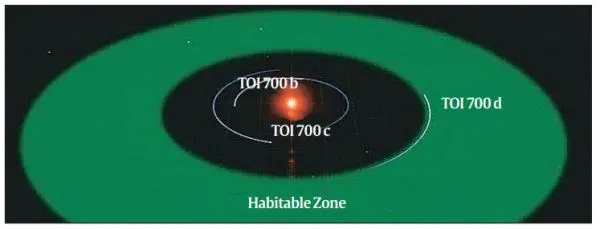Science & Technology
TOI 700 d
- 09 Jan 2020
- 3 min read
Why in News
The National Aeronautics and Space Administration (NASA) has reported the discovery of an Earth-size planet, named TOI 700 d.
- The planet was found by NASA’s Transiting Exoplanet Survey Satellite (TESS) mission, which was launched in 2018. With TOI 700 d, TESS has discovered its first Earth-size planet in its star’s habitable zone.
- In comparison to the Earth: TOI 700 d measures 20% larger than Earth. It orbits its star, TOI 700, once every 37 days.
- The star, TOI 700, is an "M dwarf" located just over 100 light-years away in the southern constellation Dorado. It is roughly 40% of the Sun's mass and size, and has about half its surface temperature.
- Two other planets orbit the star:
- TOI 700 b, which is almost exactly Earth-size, probably rocky, and which completes an orbit every 10 days.
- TOI 700 c, the middle planet, which is 2.6 times larger than Earth, is probably gas-dominated, and orbits every 16 days.
- Orbits in Habitable Zone: TOI 700 d is the outermost planet, and the only one in the TOI 700’s habitable zone.
- A habitable zone, also called the "Goldilocks zone" is the area around a star where it is not too hot and not too cold for liquid water to exist on the surface of surrounding planets.
- Earth is in the Sun’s Goldilocks zone. If Earth were where the dwarf planet Pluto is, all its water would freeze; on the other hand, if Earth were where Mercury is, all its water would boil off.
- Goldilock Zone is always defined with reference to a particular star. It can be different for different stars.
M-dwarf Star
- M dwarf or M-type star, also called Red Dwarf Star are the most numerous type of star in the universe and the smallest type of hydrogen-burning star.
- These have masses from about 0.08 to 0.6 times that of the Sun.
- In the Milky Way Galaxy, about three-fourths of the stars are red dwarfs.




